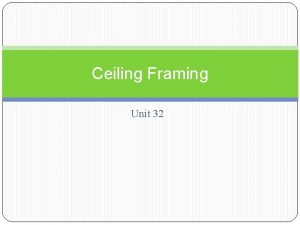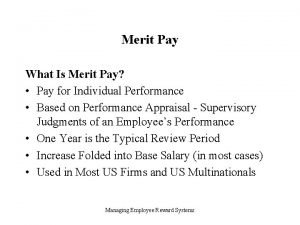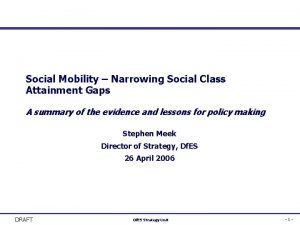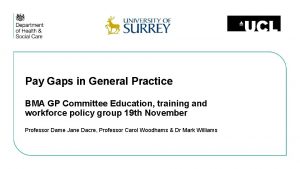The Class Ceiling Social Origin Pay Gaps in






























- Slides: 30

The Class Ceiling Social Origin Pay Gaps in the Higher Professional and Managerial Occupations Daniel Laurison Based in part on “The Class Pay Gap in Higher Managerial and Professional Occupations” by Daniel Laurison and Sam Friedman, accepted for publication in American Sociological Review 1

Social Class Mobility 2

What is Class position? No two social scientists agree! • Relation to the means of production (Marx) • Education (various Social Sciences) • Income (Economists) • “Big-Class” (dominant Sociologists) • “Micro-Class” (challenger Sociologists) • Social Space (Bourdieu) 3

The Big Classes (EGP/NS-SEC ) 1: Higher managerial, administrative and professional occupations: CEO, Professor, Stock Broker, Doctor, Military Officer 2: Lower managerial, administrative, and professional occupations: Teacher, Nurse, Store Manager, IT consultant 3: Intermediate Occupations: Bookkeeper, Secretary, Teaching Assistant 4: Self-Employed: frequently Plumbers, Carpenters, Hairdressers, Taxi Drivers 5: Lower Supervisory and Technical: Chef, Electrician, Communication Operator 6: Semi-Routine Occupations: Sales & Retail Assistant, Care Worker, Landscaper 7: Routine Occupations: Carpenter, Cleaner, Truck or Bus Driver 8: Never worked or long-term unemployed 4

Reproduction of Privilege 100% 90% 80% 70% 60% 50% 40% 30% 20% 10% 0% In whole UK In Higher Management or Professions Semi-Routine or Routine Occupation, or No Earner Parent Intermediate, Self-Employed, or Technical/Supervisory Parent Lower Managerial or Professional Parent Higher Managerial or Professional Parent 5

2. 0 Over-Representation of the Privileged in Top Jobs 1. 8 1. 6 1. 4 1. 2 1. 0 0. 8 0. 6 0. 4 0. 2 0. 0 Semi-Routine or Intermediate, Self- Lower Managerial or Higher Managerial or Routine Occupation, Employed, or Professional Parent or No Earner Parent Technical/Supervisory Parent 6

Problems with Mobility Studies • Ignores resources beyond single-variable measure of class position • Dominant focus on mobility rates between big “classes, ” on access to top jobs. • Might miss potentially important differences between or within specific high-status occupational groups 7

Data and Approach 2014 UK Labour Force Survey: Nationally representative, Government data Class Origin Question: What was the occupation of the main income earner in your household when you were 14 years old? Destination: Only those in elite occupations (NS-SEC 1/EGP 1) Higher managerial, administrative and professional occupations Excluded respondents: in full-time education, not aged 23 -69, no parental occupation data 43, 444 respondents 6, 104 in NS-SEC 1 -categorized elite occupations 3, 510 with income, origin, AND occupation data 8

n si er Of fic Po fo rm In io n at ct or Se gin En bl ic ag ee T rs er ec sa lic hn e, nd ol Fir og Di y e, re M ct ilit or si ar n Bu y sin Ar A es ch cc s ou ite nt ct s& an Bu ts sin Su es rv s. P ey or ro s fe ss io na Ac ls ad em ics S Ph cie ar nt m ist ac O s ist th F er in s, an De Pr ce of nt es ist sio s, Ps na yc ho ls La lo w ye gis rs ts & Ju dg es Do ct or s an M To p Pu Social Mobility into Elite Occupations 4. 0 3. 5 3. 0 2. 5 2. 0 1. 5 1. 0 0. 5 0. 0 Long-Range Mobile Mid-Range Mobile Short-Range Mobile Intergenerationally Stable 9

d En v ec Pr ot of e Pr ss io w La tiv na e iro C ls ivi nm l Se en rv t. P ice ro Ot fe he ss r. L io ife na ls Sc Ac ie a nc de e m Pr ics of es sio na ls Fin an ce Sc ie nt In ist fo s rm En g a in tio M ee an n B rs T us ag ec in er hn es sa ol s nd og Pr y o D fe Pu ire s bl sio ct ic or na Se si ls ct n or Bu sin M an es A ag cc s er ou s& nt an Pr ts of es sio na ls ilt Bu he r Ot or s ct Do s. e. f r i e d m a n @ l s e. a c. u k ; “Micro-Class” Over-Representation 25 20 15 10 5 0 Micro-Stable NS-SEC 1 Origins

Gender & Race/Ethnicity in the Workplace Exclusion Tokenism Glass Ceilings Pay/Earnings gaps 11

Main Research Question: A Class Ceiling? Do the upwardly mobile face a “class ceiling” in terms of earnings within higher professional and managerial occupations? 12

The Class Pay Gap (Mean Logged Weekly Earnings in NS-SEC 1 by Social Origin) 6. 8 6. 7 6. 6 6. 5 6. 4 NS-SEC 1 NS-SEC 2 NS-SEC 3 Parents (Higher Parents (Lower Parents Mgrs & Profs) (Intermediate Occs) NS-SEC 4 NS-SEC 5 NS-SEC 6 NS-SEC 7 Parents (Self- Parents (Lower Parents (Semi. Parents employed) Supervisory & Routine Occs) (Routine Occs) Tech) d. r. laurison@lse. ac. uk NS-SEC 8 Parents (No Earner in Household)

Models for Earnings Differences Dependent Variable: Logged Weekly earnings (in £) (also untransformed weekly earnings & also untransformed hourly earnings) I. Demographic & Hours Worked: Age (in years); Age squared; Female; Not White; Country of Birth: reference=England, vs outside the UK, Northern Ireland, Scotland, Wales. II. Educational Qualifications. Degree: reference= University Degree vs Ph. D, MA, Post-Grad Ed Cert, Other Post-Grad, Higher Ed, A-Levels, GCSEs, Other Qualifications, No Qualifications; Degree Class: reference= 2: 2/Lower 2 nd Class, vs N/A (e. g. no degree, foreign degree), Pass, Third Class, 2: 1/Higher Second Class, 1 st Class. III. “Human Capital”: Job-Related Training last 3 months (binary); Job Tenure (in years); Past Health Problems (scale 0 -2); Current Health Problems (scale 0 -4). IV. Work Context: Public sector (vs private); Industry: reference=Public admin, vs Education & Health, Agriculture, Forestry & Fishing, Energy & Water, Manufacturing, Construction, Distribution, Hotels & Restaurant, Transport & Communication, Banking & Finance, Other services; Firm Size, reference= less than 25 employees, vs 25 to 49, 50 to 499, 500 or more; Work region Professionals (vs Managers). V. Specific Occupation: Specific SOC 2010 code (I let Stata choose the reference category)

Origin Earnings Gaps Net of Controls MODEL III MODEL IV MODEL V ONLY DEMO- ADDING GRAPHIC ADDING HUMAN CONTROLS EDUCATION CAPITAL Origins (vs NS-SEC 1 Parents) NS-SEC 2 (Lower Mgrs & Profs) 0. 929** 0. 946* NS-SEC 3 (Intermediate Occs) 0. 880*** 0. 916** NS-SEC 4 (Self-employed) 0. 833*** 0. 872*** NS-SEC 5 (Lower Supervisory & Tech) 0. 872*** 0. 911** NS-SEC 6 (Semi-Routine Occs) 0. 818*** 0. 878*** NS-SEC 7 (Routine Occs) 0. 792*** 0. 848*** NS-SEC 8 (No Earner in Household) 0. 834*** 0. 886* 0. 947* ADDING WORK CONTEXT 0. 955* 0. 913*** 0. 932** ADDING SPECIFIC OCCUPATIONS 0. 974 0. 947* 0. 870*** 0. 899*** 0. 917** 0. 907** 0. 916** 0. 937* 0. 874*** 0. 891*** 0. 911** 0. 845*** 0. 867*** 0. 883*** 0. 889* 0. 881** 0. 897*

More Earnings Coefficients for Class Origin LOGGED WEEKLY EARNINGS NS-SEC 1 (ALL) NS-SEC 1. 1 Short-range Mobile -0. 039 NS-SEC 1. 2 -0. 013 -0. 047 Mid-range Mobile -0. 080*** -0. 077 -0. 081*** Long-range Mobile -0. 127*** -0. 108* -0. 135*** Weekly Gross Earnings (untransformed GBP) Short-range Mobile (NS-SEC 2 parents) -40. 19 -11. 81 -50. 75* Mid-range Mobile (NS-SEC 3, 4, 5) -87. 33*** -81. 65* -86. 81*** Long-range Mobile (NS-SEC 6 & 7) -115. 38*** -110. 99* -117. 45*** Hourly Gross Earnings £ Short-range Mobile -1. 118 -1. 368 -1. 072 Mid-range Mobile -2. 243*** -2. 329 -2. 112*** Long-range Mobile -3. 495*** -2. 98 -3. 308*** 798 2421 N 3219

Blinder-Oaxaca Decomposition LOGGED EXPONENTIATED VALUES P>T NS-SEC 1 origins 6. 729 £ 836. 4 0. 00 NS-SEC 3 to 8 origins 6. 582 £ 721. 8 0. 00 Difference 0. 147 115. 9% 0. 00 “Explained” 0. 068 107. 0% 44% 0. 00 “Unexplained” 0. 080 108. 3% 56% 0. 00 d. r. laurison@lse. ac. uk

Blinder-Oaxaca Decomposition continued CONTRIBUTION TO THE PAY GAP Base Model Controls Age & Age Squared Female Not White Country of Birth Quarter Responded to Survey Paid Hours Worked -25. 0% -0. 0351 -0. 0049 0. 0002 -0. 0012 0. 0010 0. 0032 Educational Qualifications Degree Classification -23. 8% -3. 4% 0. 2% -0. 8% 0. 7% 2. 2% 0. 00 0. 07 0. 70 0. 59 0. 36 0. 64 45. 0% 0. 0698 -0. 0036 Human Capital 47. 4% -2. 4% 0. 00 0. 32 -5. 3% Current Health Problems Scale Past Health Problems Scale Job Tenure in Years Job-Related training last 3 months 0. 0011 -0. 0001 -0. 0087 0. 0019 Region of Work Industry Public Sector Firm Size Specific Occupation 0. 0222 -0. 0039 -0. 0065 0. 0142 0. 0182 Work Context % OF DIFFERENCE EXPLAINED P>T 0. 7% -0. 1% -5. 9% 1. 3% 0. 26 0. 81 0. 00 0. 16 15. 1% -2. 7% -4. 4% 9. 6% 12. 3% 0. 00 0. 23 0. 00 0. 02 31. 2%

Separate Models by Age Group d. r. laurison@lse. ac. uk

Separate Models by Ethnic Group Short-Range Mobile Mid-Range Mobile Long-Range Mobile

Separate Models by Gender Short-Range Mobile Mid-Range Mobile Long-Range Mobile

Double Disadvantage for Working Class-Origin Women £ 50, 000 £ 40, 000 £ 30, 000 £ 20, 000 £ 10, 000 £ 0 Women Men Long-Range Mobile Mid-Range Mobile Short-Range Mobile Intergenerationally Stable

Class Earnings Gaps by Occupational Group (NS-SEC 3 -8 vs Stable) Base model d. r. laurison@lse. ac. uk All Controls

s. e. f r i e d m a n @ l s e. a c. u k ; d Large Private Firms in Inner London 100% 90% 80% 70% 60% 50% 40% 30% 20% 10% 0% 500+ Private firms in Inner London Other firms in Inner London long-range mobile 500+ Private Firms Other UK mid-range mobile Other Firms Other UK short-range mobile all NS-SEC 1 intergenerationally stable

s. e. f r i e d m a n @ l s e. a c. u k ; d Large London Firms’ Pay Gaps (no controls) £ 1, 800 £ 1, 600 £ 1, 400 £ 1, 200 £ 1, 000 £ 800 £ 600 £ 400 £ 200 £ 0 500+ Private firms in Inner Other firms in Inner London 500+ Private Firms Other UK London Intergenerationally Stable NS-SEC 3 -8 Origins Other Firms Other UK

s. e. f r i e d m a n @ l s e. a c. u k ; d Pay Gaps Net of Controls, Income Percentile in NS-SEC 1 in Region

The Rest of the Gap? • More sorting within occupations • Cultural Capital – Legitimate or “posh” hobbies, accent, style – Private schooling & elite university attendance • Social Capital – Who you know – “Microclass” effects • Discrimination/Stigma/Homophily • Aspirations & behavior 27

Summary of Key Findings Beyond “access” upwardly mobile face a powerful class ceiling, earning 10 – 20% less. Class-origin differences larger for men, but women face double disadvantage. Education & Sorting effects explain big part of pay gap. 60% of differences “unexplained. ” 28

Implications for Class and Mobility Studies – Importing feminist concept of “glass ceiling” provides tools for interrogating hidden class barriers within occupations – Focus on access fails to capture stickiness of class origin – Class position is best captured by multiple measures, not any single variable 29

Thank you! 30
 Paycheck
Paycheck Designing pay levels
Designing pay levels Demotivators and edward deci theory
Demotivators and edward deci theory Section 1-1 hourly pay answers
Section 1-1 hourly pay answers This lesson is important. please pay
This lesson is important. please pay Please pay attention
Please pay attention Social thinking and social influence in psychology
Social thinking and social influence in psychology Social thinking social influence social relations
Social thinking social influence social relations The social interaction source of language
The social interaction source of language Hình ảnh bộ gõ cơ thể búng tay
Hình ảnh bộ gõ cơ thể búng tay Bổ thể
Bổ thể Tỉ lệ cơ thể trẻ em
Tỉ lệ cơ thể trẻ em Gấu đi như thế nào
Gấu đi như thế nào Tư thế worm breton
Tư thế worm breton Alleluia hat len nguoi oi
Alleluia hat len nguoi oi Các môn thể thao bắt đầu bằng tiếng bóng
Các môn thể thao bắt đầu bằng tiếng bóng Thế nào là hệ số cao nhất
Thế nào là hệ số cao nhất Các châu lục và đại dương trên thế giới
Các châu lục và đại dương trên thế giới Công thức tiính động năng
Công thức tiính động năng Trời xanh đây là của chúng ta thể thơ
Trời xanh đây là của chúng ta thể thơ Mật thư tọa độ 5x5
Mật thư tọa độ 5x5 Làm thế nào để 102-1=99
Làm thế nào để 102-1=99 Phản ứng thế ankan
Phản ứng thế ankan Các châu lục và đại dương trên thế giới
Các châu lục và đại dương trên thế giới Thể thơ truyền thống
Thể thơ truyền thống Quá trình desamine hóa có thể tạo ra
Quá trình desamine hóa có thể tạo ra Một số thể thơ truyền thống
Một số thể thơ truyền thống Cái miệng bé xinh thế chỉ nói điều hay thôi
Cái miệng bé xinh thế chỉ nói điều hay thôi Vẽ hình chiếu vuông góc của vật thể sau
Vẽ hình chiếu vuông góc của vật thể sau Thế nào là sự mỏi cơ
Thế nào là sự mỏi cơ





















































